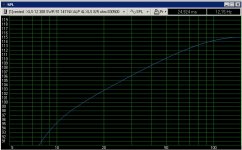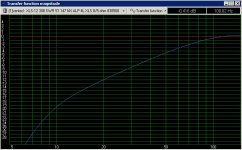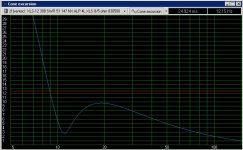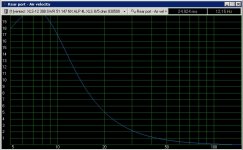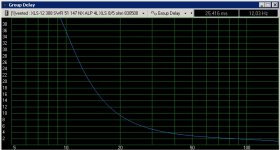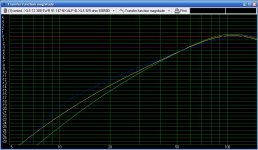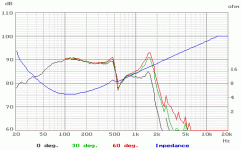Dual XLS-12" sub design, cracked it? thoughts?
Idea:
Subwoofer with good output; 15Hz-40Hz for music and 15Hz-60Hz for movies.
Port only active in lower regions to prevent smearing.
No port noise.
Low Q. Low group delay.
Netto box volume max 110L.
Design:
2x Peerless XLS 12
Box 110L netto, small amount of fill, tuning frequency 11Hz
1x tube 11,1cm inner size, 209,4cm length
1x 240W NAD214 amp
Pro's:
good output <20Hz
1st port resonance 82Hz
cone excursion limit only reached below 9Hz with 240W
low group delay 25ms at 12Hz
Air velocity in tube 17m/s at 240W at 10Hz
Reasonable box size.
I'll post the screens from winisd.
Any thoughts about this design? Did I miss something?
Sjoerd
Idea:
Subwoofer with good output; 15Hz-40Hz for music and 15Hz-60Hz for movies.
Port only active in lower regions to prevent smearing.
No port noise.
Low Q. Low group delay.
Netto box volume max 110L.
Design:
2x Peerless XLS 12
Box 110L netto, small amount of fill, tuning frequency 11Hz
1x tube 11,1cm inner size, 209,4cm length
1x 240W NAD214 amp
Pro's:
good output <20Hz
1st port resonance 82Hz
cone excursion limit only reached below 9Hz with 240W
low group delay 25ms at 12Hz
Air velocity in tube 17m/s at 240W at 10Hz
Reasonable box size.
I'll post the screens from winisd.
Any thoughts about this design? Did I miss something?
Sjoerd
The first room resonance is at ~28Hz, so I expect higher output below this frequency. With an active crossover and correction filter, I expect a flat response till well below 20Hz. (15Hz?)
Sjoerd
Sjoerd
Looks to me like not much different to a pair of sealed subs, which would actually give you more flexibility. This might not be the response you are looking for, but why not just use a pair of small sealed subs with a LT? They may give you a better in-room response that way, or if placed next to the mains they may give a better integration since distortion products will be close to the mains. Distortion can cause localisation problems with any subwoofer driver.
I've had bad experiences using NAD power amps with subwoofers. I powered my pair of drivers with a 2100 and watched firewords inside the amp when a transient hit. It just blew up! I would be very wary of this. The XLS is very easily powered with a moderate and affordable plate amp.
In room response is difficult to predict. I have simulated my room, and I have used measurements and they are nothing alike! Keep that in mind. You need something fairly sophisticated to deal with room modes like BFD.
How are you going to switch between music and HT mode? I'm not sure the difference will be worth the hassle in the long run. I've seen (and more importantly, heard) the XLS used in ultra high end cost-no-object speakers and they are great drivers. Done right they should sound very accurate.
I can't see anything wrong with what you planned, or anything you missed as such. I'm just suggesting alternatives.
I've had bad experiences using NAD power amps with subwoofers. I powered my pair of drivers with a 2100 and watched firewords inside the amp when a transient hit. It just blew up! I would be very wary of this. The XLS is very easily powered with a moderate and affordable plate amp.
In room response is difficult to predict. I have simulated my room, and I have used measurements and they are nothing alike! Keep that in mind. You need something fairly sophisticated to deal with room modes like BFD.
How are you going to switch between music and HT mode? I'm not sure the difference will be worth the hassle in the long run. I've seen (and more importantly, heard) the XLS used in ultra high end cost-no-object speakers and they are great drivers. Done right they should sound very accurate.
I can't see anything wrong with what you planned, or anything you missed as such. I'm just suggesting alternatives.
looks like a great box to me.... except your rolloff is a bit steep. A bigger box would help with that, but it also lowers the dampening on the cone which will increase excursion at lower power levels. I'd say virtually what you have there is a sealed box with an extra few Db from 11-13hz or something. I like it. It should sound very musical indeed.
Thanks for the response.
What do you mean with LT? Transmission Line?
Thought about it; it has two downsides:
-a large box
-haven't found the right simulation software
I'm thinking about buying a plate amp, but currently I'm using another XLS-12 sub (single driver) and it works out great.
The NAD214 has softclipping, so I'm probably save.
I agree, I want to build a crossover + correction filter.
Possibly with a notch filter for the first resonance.
With the filter mentioned above, I should be able to switch between crossover frequency easily.
Thx
paulspencer said:Looks to me like not much different to a pair of sealed subs, which would actually give you more flexibility. This might not be the response you are looking for, but why not just use a pair of small sealed subs with a LT? They may give you a better in-room response that way, or if placed next to the mains they may give a better integration since distortion products will be close to the mains. Distortion can cause localisation problems with any subwoofer driver.
What do you mean with LT? Transmission Line?
Thought about it; it has two downsides:
-a large box
-haven't found the right simulation software
I've had bad experiences using NAD power amps with subwoofers. I powered my pair of drivers with a 2100 and watched firewords inside the amp when a transient hit. It just blew up! I would be very wary of this. The XLS is very easily powered with a moderate and affordable plate amp.
I'm thinking about buying a plate amp, but currently I'm using another XLS-12 sub (single driver) and it works out great.
The NAD214 has softclipping, so I'm probably save.
In room response is difficult to predict. I have simulated my room, and I have used measurements and they are nothing alike! Keep that in mind. You need something fairly sophisticated to deal with room modes like BFD.
I agree, I want to build a crossover + correction filter.
Possibly with a notch filter for the first resonance.
How are you going to switch between music and HT mode? I'm not sure the difference will be worth the hassle in the long run. I've seen (and more importantly, heard) the XLS used in ultra high end cost-no-object speakers and they are great drivers. Done right they should sound very accurate.
With the filter mentioned above, I should be able to switch between crossover frequency easily.
I can't see anything wrong with what you planned, or anything you missed as such. I'm just suggesting alternatives.
Thx
What do you mean with LT? Transmission Line?
Thought about it; it has two downsides:
-a large box
-haven't found the right simulation software
LT = Linkwitz Transform
It is a customised eq filter that allows you to put a driver in a sealed box smaller than would otherwise be acceptable due to the resultant high Q, a peak at the upper end of the bass and limited F3. The LT lowers to Q to the desired result, removes the peak and gives eq to the specified point. Hence you can put pretty much any 12" driver in a 1cu ft sealed box with a LT designed for that driver and box. The only limitation is output. Many comercial subs do this to get the sub small.
More info:
http://sound.westhost.com/linkwitz-transform.htm
http://sound.westhost.com/project71.htm
You can get PCBs there to make your own.
TLs are another thing altogether. If you wanted to go down that path, we can direct you to Martin King's mathcad program, which many on this forum have used.
I'm thinking about buying a plate amp, but currently I'm using another XLS-12 sub (single driver) and it works out great.
Plate amp - good idea. In the meantime, be gentle! I was temporarily using my NAD 2100 power amp for a pair of subs, and I blew it up!
 ... the fact that it had soft clipping did not help, nor did the fact that it has overload protection (which is meant to shut down when the amplifier is overdriven - and it did do that once). My case was probably one of bad luck, but I suggest caution nevertheless.
... the fact that it had soft clipping did not help, nor did the fact that it has overload protection (which is meant to shut down when the amplifier is overdriven - and it did do that once). My case was probably one of bad luck, but I suggest caution nevertheless. I agree, I want to build a crossover + correction filter.
When you get a plate amp, you will already have a crossover included. What you really need (ideally) is a parametric eq with a number of bands. You can diy one of them or you can buy something that will do it with analogue filters, or digital. My preference is for something more sophisticated like BFD.
Are you experienced with diy electronics? One thing I've found is that even cheap consumer electronics have many things taken care of that a typical diy unit won't - turn on/off transients are already taken care of and they are safe, fairly well constructed and hassle free. A plate amp takes care of your filter and turns itself on automatically. My subwoofer processor just for the filter and volume control have to be turned on, as does my power amp separately, and when I turn off the system, I have to turn down the passive attenuators AS WELL AS turning it off first, since it holds so much power in reserve that the thump I get from turning off Ultracurve DEQ will shake the house!
I recently put together a cheap subwoofer for my parents using a plate amp, and it is much less hassle - all you have to do is set it up and leave it. Mine has a specific turn on/off sequence which is a chore.
Conclusion: IMO most diyers would be best served with a plate amp and something like BFD for room modes
With the filter mentioned above, I should be able to switch between crossover frequency easily.
I doubt it would be worth the bother, but you will be able to decide on that later. Are you relying on the acoustic rolloff of your mains? Or do you plan to have a filter on them as well?
BassAwdyO said:looks like a great box to me.... except your rolloff is a bit steep. A bigger box would help with that, but it also lowers the dampening on the cone which will increase excursion at lower power levels.
The rolloff is not so steep in my opinion (look at the scale; 5-150Hz)
For comparison take a look at the attachment
Green is the design by Linkwitz (www.Linkwitzlab.com)
Yellow is the sub I own at this moment
Blue is the new design
I'd say virtually what you have there is a sealed box with an extra few Db from 11-13hz or something. I like it. It should sound very musical indeed.
I like sealed subs. So my idea was to create a sealed sub, but with some extra output from a port for the part where the system would run out of steam.
By placing the port it prevents the cone from reaching it's max excursion at ~16Hz instead it's at 9Hz with 240W.
Attachments
Remember down low your ears are less sensitive, so a few extra db even at 20 Hz is nothing to get excited about. Now you are talking down well below that. A pair of XLS drivers don't really have the displacement to have worthwhile output donw that low IMO. For very low LFE I'd consider an EBS using those drivers to get down to say 15 Hz. With the 4x XLS I found you can get performance identical to the Genelec top of the range subwoofer which won a comparison with subs like Velodyne, Adire Sadhara and the Servodrive Contrabass. The Genelec uses 250w per driver and ~70L box if I recall correctly. With a little eq I was able to get identical output and extension, almost to the point that I thought they did actually use the XLS.
Adire have a design using a vented sub designed along similar lines, which you might find interesting.
Adire have a design using a vented sub designed along similar lines, which you might find interesting.
I'm pretty sure they did use the XLS 12''?? look at the specs on the woofer they are using. Every single spec is the exact same as the peerless xls.
You will please excuse me for intruding but are these 8 ohm XLS or 4 ohm. It seems the 4 ohm gives a better result with my superficial assessment but 2.2 ohm min - when will these spkr designers ever learn to stick within the boundaries! I have to design amps to drive these - without degradation. Besides I don't find either driver especially suited to the small box big extension syndrome.
Looking elsewhere with bass assist and ULP filter.
Looking elsewhere with bass assist and ULP filter.
Chris, I once posted that I thought the Genelec was based on the XLS driver, based on its performance, look and parameters. That was until I actually saw one in real life and peered through the grille. The driver looks just slightly different in real life. Perhaps they are an OEM version of the XLS, I would think they likely have different parameters, as the XLS requires some filtering to deal with the early rolloff, hence you get an F3 that is ridiculously high and their sub is in effect an EBS even though it's not that large for 4 x 12" drivers.
guru,
I hear ya, that's one thing that bothers me about the XLS - it should be a 4 ohm driver, but has to be 8 ohm for a typical amp stable down to 4. I don't like the way it sims, early rolloff and hard to get 20 Hz extension ... however it's a very good quality driver, and in Australia it can be bought very cheaply relative to all other quality subs.
guru,
I hear ya, that's one thing that bothers me about the XLS - it should be a 4 ohm driver, but has to be 8 ohm for a typical amp stable down to 4. I don't like the way it sims, early rolloff and hard to get 20 Hz extension ... however it's a very good quality driver, and in Australia it can be bought very cheaply relative to all other quality subs.
Re: Dual XLS-12" sub design, cracked it? thoughts?
Are you planning on having this approximatley 4.25" pipe sticking out of your enclosure that is approximately 80" long?
I am thinking since you are considering an enclosure of almost 4 cubes, you can do better than using the peerless XLS drivers.
Am I missing something in the translation/conversion here? Just wondering...
Noidster
Sjoerd v L said:Design:
2x Peerless XLS 12
Box 110L netto, small amount of fill, tuning frequency 11Hz
1x tube 11,1cm inner size, 209,4cm length
1x 240W NAD214 amp
Are you planning on having this approximatley 4.25" pipe sticking out of your enclosure that is approximately 80" long?
I am thinking since you are considering an enclosure of almost 4 cubes, you can do better than using the peerless XLS drivers.
Am I missing something in the translation/conversion here? Just wondering...
Noidster
paulspencer said:When you get a plate amp, you will already have a crossover included. What you really need (ideally) is a parametric eq with a number of bands. You can diy one of them or you can buy something that will do it with analogue filters, or digital. My preference is for something more sophisticated like BFD.
A parametric eq with really small bands in the (sub)bass region would be ideal...
The BFD could be an option.
Are you experienced with diy electronics? One thing I've found is that even cheap consumer electronics have many things taken care of that a typical diy unit won't - turn on/off transients are already taken care of and they are safe, fairly well constructed and hassle free. A plate amp takes care of your filter and turns itself on automatically. My subwoofer processor just for the filter and volume control have to be turned on, as does my power amp separately, and when I turn off the system, I have to turn down the passive attenuators AS WELL AS turning it off first, since it holds so much power in reserve that the thump I get from turning off Ultracurve DEQ will shake the house!
Yes I have some experience with diy electronics. If I combine a diy correction filter (low freq boost) with a plate amp, I would be OK.
Does the Ultracurve DEQ have enough resolution and settings for low frequencies? (10-30Hz)
I doubt it would be worth the bother, but you will be able to decide on that later. Are you relying on the acoustic rolloff of your mains? Or do you plan to have a filter on them as well?
I'm relying on the acoustic rolloff of my mains, they (Dynaudio Contour 2.8) have a (measured) response to 30Hz.
paulspencer said:Remember down low your ears are less sensitive, so a few extra db even at 20 Hz is nothing to get excited about. Now you are talking down well below that.
Good point, but you mixup two things, at low frequencies you need more SPL to be aware of them, but a change in SPL has more effect. Linkwitz says it like this.
Linkwitz
A change of 10 phon corresponds to a perceived doubling of loudness. At 1 KHz the SPL must change (by definition) 10 dB to obtain this doubling, but at 20 Hz it takes only about 5 dB for the same effect. This is the reason why changes of only a few dB in subwoofer level setting have a large perceived effect. Adding a second subwoofer for 6 dB more SPL, or for lower distortion at the initial SPL, can give the subjective benefits of up to 12 phon.
http://www.linkwitzlab.com/thor-measmt.htm
But your point got me thinking, that's why I posted the other threat about Equal-Loudness Curves for low frequencies.
I concluded that for really low frequencies you need a LOT of SPL so it is pointless for me to aim for, say 10Hz. So now I shift the resonance frequency of the port to a slightly higher point (15Hz or so). As a result I will get more SPL from 15Hz and up, and don't waste it on a part that's not going to be able to give enough output to be significant.
amplifierguru said:You will please excuse me for intruding but are these 8 ohm XLS or 4 ohm.
Peerless Data Sheet
SWR 308
308 SWR 51 147 NX ALP 4L XLS 8/5 ohm
Nominal impedance Zn (ohm) 8
DC resistance Re (ohm) 3.5
Attachments
- Status
- Not open for further replies.
- Home
- Loudspeakers
- Subwoofers
- Dual XLS-12" sub design, cracked it? thoughts?
